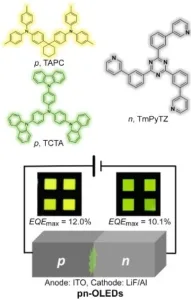Researchers from the South China University of Technology (Guangzhou, China) are developing a new Organic Light Emitting Diode (OLED) structure. It is claimed to have the potential to enable low cost, highly efficient fluorescent OLED devices. The so-called pn-OLED structure is described as drawing upon conventional p-n junction theory and inorganic LED design.
First, a few words of background information.
A conventional OLED is typically configured from three types of semiconductors: a p-type hole-transport layer, an n-type electron-transport layer and an emission layer. The luminescent property of an OLED mainly depends on the fluorescence behavior of single molecule emitters. The driving voltages of OLEDs are generally higher than traditional inorganic LEDs.
The materials used in and configuration of the new pn-OLED is different than that of a conventional OLED. It is based on a highly efficient, emission-layer-free OLED structure. “The p-type and n-type organic semiconductor materials are sandwiched vertically between an indium tin oxide anode and a lithium fluoride/aluminum cathode. The luminescent center of the pn-OLED is located in the p-n junction region. The light emission behavior of the device is, therefore, a result of the synergetic energy release from both the p-type and n-type materials.”
The top part of the figure below illustrates the molecular structures of the p-type and n-type organic semiconductor materials used in the pn-OLED. The bottom part of the figure illustrates the configuration of the pn-OLED.
The pn-OLED exhibits a high, peak external quantum efficiency of up to 12%. Given that the light out coupling efficiency of the device is ~20%, the internal quantum efficiency should be quite high at ~60%.
With these results, the researchers have shown that using only purely organic p-type and n-type semiconductors, pn-OLEDs have the potential for achieving an efficiency close to the theoretical maximum.
The new pn-OLEDs also have a low operating voltage. It is, therefore, feasible to produce devices that have a high power conversion efficiency. It follows that the new pn-OLEDs may be well suited for use in applications in which it is important to minimize energy consumption.
The researchers believe it should be simple to adjust the emission color of a pn-OLEDs by adjusting the combination of materials used in the p-n junction.
The fundamental theory used to interpret the behavior of organic semiconductors is still in dispute. As a result, the researchers anticipate that part of their future work will be to investigate the operating mechanism of the pn-OLED. The researchers also wish to “examine the underlying connections of the working principles of both organic and inorganic p-n junction LEDs.” The researchers hope that such work may provide a way to understand the similarity between the intrinsic properties of organic and inorganic semiconductors. -Arthur Berman

